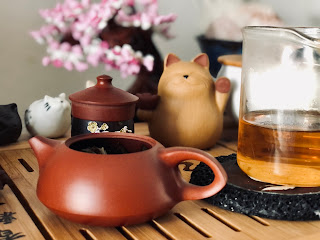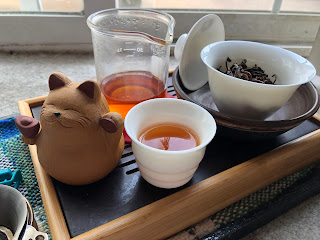Tea Tasting: Gold Thread Honey Orchid

Tea Information

- Type: Phoenix / Dan cong oolong
- Vendor: West China Tea
- Recommended brew: 205@5-7 seconds
- Cost per gram: $1.10
Gold Thread Honey Orchid (金絲密蘭香, Jīn Sī Mì Lán Xiāng, "Gold Thread Honey Orchid Fragrance") is a sub-cultivar of Honey Orchid, which is one of the most popular breeds of Phoenix Oolong. It is so named because it is cloned from a particular Honey Orchid plant whose leaves are golden in color as opposed to green.
Farmers discovered that this golden plant, in addition to its unusual coloring, also had a distinctive flavor and fragrance from its siblings. This tea exhibits a biscuit-y, slightly spicy aroma on top of the classic fruity sweetness of Honey Orchid. Like most Phoenix Oolongs, the dry leaf is dark, almost black. Whereas regular Honey Orchid and most other Phoenix Oolongs have leaves that end up green after multiple steepings, the spent leaves of Gold Thread Honey Orchid have a deep bronze color.
Because it is a less-common sub-cultivar and has only been grown for a few generations, it is easier to get Gold Thread Honey Orchid that is closer, genetically, to the original mother tree. As a result, the Qi is also superior to normal grades of Honey Orchid.
Tea Session 1
- Teaware: Gaiwan 110ml
- Water Amount: ~ 100ml
- Tea Amount: 5.19
- Brewing Temperatures: 198, 200-206
- Time (seconds): 10, 20, 30, 48
- High notes of the aroma: Sweet, fruity,
- Low notes of the aroma: Cooked stone fruit, smoke, roasted
- Leaves: Wiry strips
- Broth:
- 1st infusion


- 2nd Infusion


- 3rd: 30 seconds -- The fruity taste is still there, but a slightly bitter aftertaste. For the next one, I should lower the temperature
- 4th: 48 Seconds -- This seems to have helped a bit with the bitterness. It's still fairly fruity, but I can tell that it's starting on the decline.
Tea Session 2
 h
h- Teaware: Shou Zhi Chaozhou Pot by Master Lin
- Brew Style: Slight Chaozhou style. I crush some of the leaves.
- Water Amount: ~ 130 ml
- Tea Amount: 5.74
- Brewing Temperatures: 200+
- Time (seconds): 20
- High notes of the aroma: Sweet -- sugar or honey depending on the steep -- with mild floral notes
- Low notes of the aroma: A form of stone fruit sweetness. In later infusions, spearmint!
- Leaves: Wiry strips
- Broth:
- 1st Infusion: 20 seconds @ ~200F. The first steep is delicate with honey notes and mild astringency. It's slightly viscous.
- 2nd Infusion: 30 sec @ ~200F. This tastes much sweeter and absolutely no astringency.
- 3rd Infusion: 40-60?? sec @~200F. I lost track of this steep, but I definitely let it steep for too long. There's a mild bitterness to this broth
- 4th: 45 seconds -- There's still that slight bitterness again. In the previous session, I noted it as well. This broth still has a mild viscosity & astringency. Interestingly enough, there's a faint whiff of spearmint coming from the leaves in the teapot, but not in the broth
- 5th: 195 @ 45 seconds --

Summary
From Tea Session 1: Overall, this is a really good tea with nice fruity, honey flavors. It starts off well with short steeps at higher temps. I tend to like my teas a little on the stronger side, but WCT's recommendations are pretty spot on with the tea, although I did drop the water temperature slightly starting at #3, because I was noticing a bitterness not present in the first two.
From Tea Session 2: Again, a good tea. I can't honestly tell if the Chaozhou is better than the porcelain gaiwan. My notes are too close without any discernible "WOW" factor when drinking this tea. I tried steeping this for slightly longer than previous (starting at 20seconds for the first one), and I didn't perceive any improvement in the tea.
The most interesting change was the hint of spearmint aroma around steep #4, as well as the bitterness appearing at this infusion, versus #3.
Other thoughts: The tea is acceptable at about 4-5 steeps before it starts to decline in the flavor notes, although it maintains its viscosity throughout. It's close enough to other Honey Orchid that you might not notice a difference in a side-by-side comparison, although the texture and viscosity is slightly different (at least to me)
If I had more of this tea, I think I would also try it in much more thin-walled Zhuni Yixing teapot as a comparison with this Chaozhou teapot. I also think that this would be EXCELLENT as cold-brewed. The cold water would negate any of the very mild bitterness I noticed in later steeps.
Insofar as the statement, "As a result, the Qi is also superior to normal grades of Honey Orchid." I do agree with this statement. I generally find that I drink honey orchid more for flavor than any cha qi, and this tea does have more than other honey orchids, but not as much as other teas I've drank. YMMV.
Will I order more? I'm unsure. Certainly this is good, but I've also had some excellent Phoenix honey orchids at a lower price point, especially if you want to introduce non-tea drinkers to a form of dan cong. It was definitely worth trying.


Comments
Post a Comment